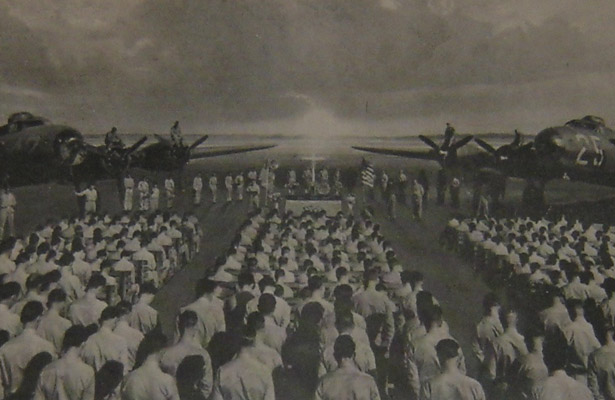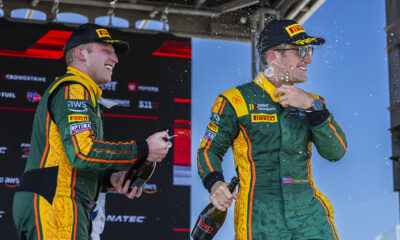
Photo: Sebring Archives
Long before sports cars challenged the tough Sebring circuit, another race took place at Sebring with much higher stakes. It was the race to train B-17 combat crews during World War II that eventually gave birth to Sebring International Raceway.
The United States was not yet officially involved in WWII when construction began for what was called the “Sebring Basic Flying School” military base in 1941.
Nestled among the orange groves and cattle ranches of Highlands County, the site was ideal because it offered favorable year-round flying weather, essential for training (indeed, during the four years of operation, the air base had only one day in which weather prevented any takeoffs).
After the Dec. 7, 1941, attack on Pearl Harbor, the pace of construction was accelerated. The first B-17s arrived in Sebring in January 1942, and within a few months a massive military base was constructed.
It was quite literally its own city, with everything you could imagine such as barracks, hospital, church, classrooms, supply store, and recreational facilities such as two swimming pools, a baseball field, movie theater and a bowling alley. The base had its own weekly paper and a Tampa radio station had a daily show devoted to recreational activities at the base.
Sebring’s airfield was officially named Hendricks Field in honor of Lt. Laird W. Hendricks, a Floridian who had been killed in England flying with the RAF.
Pilots, navigators and crewmen were trained at Hendricks Field for combat missions, while others were trained to be the all-important ground crews, maintaining the Flying Fortresses. The workhorse of Hendricks Field was “Lightning Jim,” a B-17 that logged an astonishing 8,000 hours of flying time, representing 335 days in the air.
A sobering thought- in addition to over 30 men killed in training accidents at Hendricks Field, hundreds of combat crewmen trained at Hendricks Field never returned from the European and Pacific theaters of war. The grounds of Sebring International Raceway are certainly sacred in this regard.
At the end of the war, Hendricks Field was deactivated. On Jan. 1, 1946, it was officially turned over to the City of Sebring as a municipal airport.
The deserted airbase slowly evolved into an industrial park. Today, only a few structures remain at the Sebring Regional Airport that were part of Hendricks Field, among them are the original control tower and the flagpole that marked the center of the airfield (located just behind Turn Three).
Of course, the Hendricks Field runways and taxiways still are an important part of the raceway. Turn 17, the front straight and Turn One still have the original Hendricks Field concrete poured in late 1941.
Sebring’s motor racing history can be credited to Alec Ulmann, a Russian immigrant who had an engineering degree from MIT and spoke numerous languages fluently.
Traveling to Sebring’s Airport while conducting business for his aviation company, he was intrigued by the expansive runways and taxiways combined with the unique network of roads within the abandoned military base.
To Ulmann, this would make the ideal place for a sports car race. And in particular, an endurance race run in the spirit of the Le Mans race in France, an event Ulmann had frequently attended prior to WWII.
Ulmann convinced sports car racing pioneer Sam Collier and Sports Car Club of America (SCCA) officials Bob Gegen and Phil Stiles to consider the circuit for an endurance race.
Ulmann had been an official at the Watkins Glen road races, and he was a supporter of the proposed “Around the Houses Road Race” scheduled for downtown West Palm Beach in December 1949. The event was postponed and eventually relocated to the new Palm Beach Shores Development.
South Florida, and Palm Beach in particular, was a hotbed of wealthy sports car racing enthusiasts. Although the Palm Beach Shores race in January 1950 was considered a success, Ulmann believed an endurance race at Sebring offered far more potential.
The SCCA supported his idea and the first Sebring Endurance Grand Prix was scheduled for Dec. 31, 1950. Following the death of Sam Collier at the Watkins Glen Grand Prix in 1950, the inaugural Sebring race was renamed the “Sam Collier Memorial Grand Prix of Endurance.”
Scheduled for six hours, it was to be run in accordance to the rules of Le Mans, but with a major difference. A handicap formula was devised to determine the winner, in theory giving smaller displacement cars a chance to compete evenly with more powerful machines.
Serious preparations were underway for the first ever Sebring race by the fall of 1950. The SCCA sent out entry forms and Ulmann organized the race on a local level. The first race at Sebring was becoming a reality.
Part Two of “Runways to Raceways” coming next week…


























